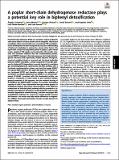Por favor, use este identificador para citar o enlazar a este item:
http://hdl.handle.net/10261/282806COMPARTIR / EXPORTAR:
 SHARE SHARE
 CORE
BASE CORE
BASE
|
|
| Visualizar otros formatos: MARC | Dublin Core | RDF | ORE | MODS | METS | DIDL | DATACITE | |

| Título: | A poplar short-chain dehydrogenase reductase plays a potential key role in biphenyl detoxification |
Autor: | Contreras, Ángela; Merino Pérez, Irene CSIC ORCID; Domínguez-Álvarez, Enrique CSIC ORCID ; Bolonio, David; Ortiz, José-Eugenio; Oñate-Sánchez, Luis; Plaza Gómez, Luis Manuel CSIC | Palabras clave: | PCB Populus Persistent organic pollutants Phytoremediation |
Fecha de publicación: | 31-ago-2021 | Editor: | National Academy of Sciences (U.S.) | Citación: | Proceedings of the National Academy of Sciences of the USA 118(35): e2103378118 (2021) | Resumen: | Polychlorinated biphenyls (PCBs) are persistent organic pollutants with severe effects on human health and the biosphere. Plant-based remediation offers many benefits over conventional PCB remediation, but its development has been hampered by our poor understanding of biphenyl metabolism in eukaryotes, among other factors. We report here a major PCB-responsive protein in poplar, a plant model system capable of PCB uptake and translocation. We provide structural and functional evidence that this uncharacterized protein, termed SDR57C, belongs to the heterogeneous short-chain dehydrogenase reductase (SDR) superfamily. Despite sequence divergence, structural modeling hinted at structural and functional similarities between SDR57C and BphB, a central component of the Bph pathway for biphenyl/PCB degradation in aerobic bacteria. By combining gas chromatography/mass spectrometry (GC/MS) profiling with a functional complementation scheme, we found that poplar SDR57C can replace BphB activity in the upper Bph pathway of Pseudomonas furukawaii KF707 and therefore catalyze the oxidation of 2,3-dihydro-2,3-dihydroxybiphenyl (2,3-DHDB) to 2,3-dihydroxybiphenyl (2,3-DHB). Consistent with this biochemical activity, we propose a mechanism of action based on prior quantum studies, general properties of SDR enzymes, and the modeled docking of 2,3-DHDB to the SDR57C-NAD+ complex. The putative detoxifying capacity of SDR57C was substantiated through reverse genetics in Arabidopsis thaliana Phenotypic characterization of the SDR lines underscored an inducible plant pathway with the potential to catabolize toxic biphenyl derivatives. Partial similarities with aerobic bacterial degradation notwithstanding, real-time messenger RNA quantification indicates the occurrence of plant-specific enzymes and features. Our results may help explain differences in degradative abilities among plant genotypes and also provide elements to improve them. | Descripción: | 9 Pág. Centro de Biotecnología y Genómica de Plantas (CBGP) | Versión del editor: | https://doi.org/10.1073/pnas.2103378118 | URI: | http://hdl.handle.net/10261/282806 | DOI: | 10.1073/pnas.2103378118 | ISSN: | 0027-8424 |
| Aparece en las colecciones: | (INIA) Artículos |
Ficheros en este ítem:
| Fichero | Descripción | Tamaño | Formato | |
|---|---|---|---|---|
| A-poplar-short-chain-dehydrogenase.pdf | artículo | 1,78 MB | Adobe PDF |  Visualizar/Abrir |
CORE Recommender
PubMed Central
Citations
2
checked on 12-abr-2024
SCOPUSTM
Citations
6
checked on 11-abr-2024
WEB OF SCIENCETM
Citations
5
checked on 27-feb-2024
Page view(s)
52
checked on 18-abr-2024
Download(s)
41
checked on 18-abr-2024

